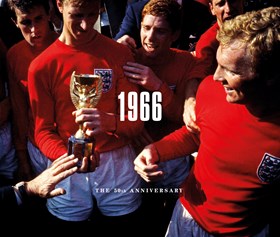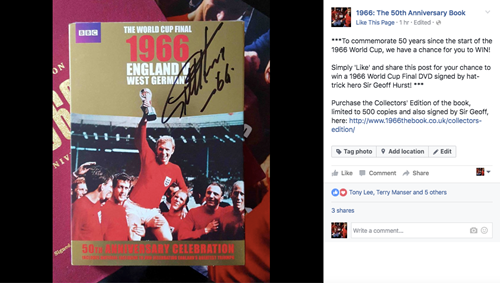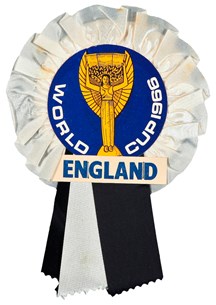
News and Links
A page dedicated to the book and all things World Cup 1966.
The Group Stage
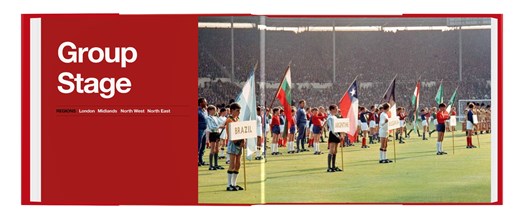
England began their EURO 2016 campaign on Saturday night with an unfortunate 1-1 draw against Russia. Despite dominating the game and putting in a performance that some pundits have claimed to be their best since EURO 2004, the Three Lions let a 1-0 lead slip in the dying moments of the match. In what was always likely to be a tricky, yet winnable group, do England have what it takes to come out on top?
In 1966, England were expected to make light work of the opponents in their group - Uruguay, Mexico and France; three sides that would constitute a far more formidable challenge in today’s variation of the game. To add to the general sense of optimism sweeping the country, the hosts went into the tournament in tremendous form, having won nine and drawn one of their previous 10 matches.
England’s first match was against Uruguay on Monday 11th July and was, on paper at least, to represent their toughest challenge in the group. Uruguay were two-time world champions and had won all four of their qualifiers. Alf Ramsey selected his favoured 4-3-3 formation, and made one change from the side that beat Poland 1-0 in their final warm-up match, bringing in Manchester United’s John Connelly for West Ham’s Martin Peters. England were fully prepared when, an hour before kick-off, Istvan Zsolt, the Hungarian referee, entered the home dressing room and asked to see official FIFA identity cards which had been issued to players to prevent teams from fielding ineligible players. Only four of the starting XI had them, so a police motor cyclist was required to make a dash to the squad’s base at the Hendon Hall Hotel to collect them. Luckily, he made good time and the players were able to play! If only the match itself had been as exciting. Uruguay’s ultra-defensive tactics made for a drab match, with one reporter referring to the South Americans as an impenetrable “blue blanket”. The match finished 0-0 and, like today, the media and fans lambasted the squad for their disappointing opening fixture, despite dominating proceedings.
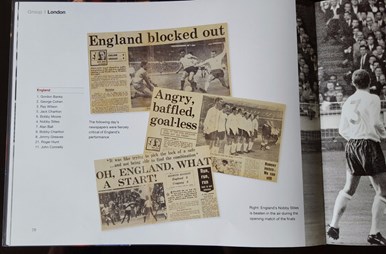
The reaction on the following morning's back-pages
After watching England fail to score at Wembley for the first time since 1938, Alf Ramsey decided to make two changes for their second match against Mexico. Southampton winger Terry Paine came in for John Connelly, and Martin Peters came in for Alan Ball. The group was wide open after the first round of fixtures as Mexico had drawn 1-1 with France, meaning that a victory for England would put them in the driving seat. The last time Mexico had visited Wembley, in 1961, England had won 8-0 with Bobby Charlton netting a hat-trick; it was little wonder, then, that the home fans expected goals. For more than half an hour, the Mexican backline absorbed all of England’s pressure, until Roger Hunt had a goal ruled out for offside. The offside goal seemed to have shaken Mexico, as two minutes later Bobby Charlton had broken the deadlock, scoring his and his country’s first goal of the tournament. Peters intercepted a Mexican move in his own half and quickly passed to Hunt, who laid the ball off to Charlton who carried the ball forward before unleashing a pile-driver into the top corner. 15 minutes from time England doubled their lead, with Hunt tapping in a rebound from an effort from Jimmy Greaves. The match ended 2-0 and, despite being up and running with three points and two clean sheets, press reaction was still fairly muted.
England knew that a draw, or even a one-goal defeat, would see them through to the knock-out stages in their final group match against France. Uruguay had beaten France 2-1 in match day two, meaning the Europeans would struggle to make it through. Though, the last time that the French had met the English, in February 1963, they hammered them 5-2; so a repeat of that result would see them progress at the host’s expense. This was, however, a very different French team, made up of largely inexperienced players due to former key men retiring. An early injury set-back for the French meant that they had to play the match with ten men, as substitutes did not yet exist. Midfielder, Robert Herbin, collided with Bobby Moore in a 50/50 challenge and was forced to limp off. In a match where England struggled to get going, it wasn’t until five minutes before half-time that they took advantage of France’s ten men. Greaves crossed from the left and the towering Jack Charlton headed against the post; the ball seemingly rolled across the line to Roger Hunt, who tapped it home. The killer second goal came 15 minutes from time, as Ian Callaghan floated in a cross for Hunt to head goalwards, leaving the French goalkeeper flapping as he palmed the ball over the line. England won the match 2-0, securing them passage to the knock-out stages as group winners. The single downside was the injury sustained by Jimmy Greaves, the man who many experts believed could fire England to glory. Greaves suffered a nasty gash on his left leg, leaving him crooked for, what would turn out to be, the remainder of the tournament.
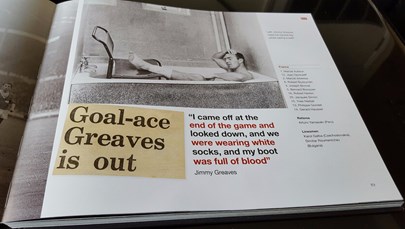
Jimmy Greaves nursing his injured leg after the France match
So, there is still hope for England’s current crop of players in France. If we can get the ball rolling against a a strong Bales (sorry, Wales) side, then there’s no reason we shouldn’t move to the top of the group. Do you think we can repeat the same feat of 1966?
Plenty more about the group stage matches can be uncovered in the book itself
The Big Kick-Off
Monday will mark 50 years since the 1966 World Cup finals got under way in England; the nation's maiden (and only) turn at hosting the tournament.

Generally considered the first truly commercial World Cup (and for that matter, the first commercial sporting event), with its wide range of collectibles and memorabilia - ranging from tea towels to t-shirts, pocket watches to postage stamps, and Airfix kits to, inexplicably, an Action Man doll - there's no doubt that the pre-tournament buzz was considerably more akin to what we are used to today.
A far from glitzy opening ceremony took place before the first match - England vs Uruguay - at Wembley. Dozens of schoolboys, led by those representing the World Champions Brazil, paraded around the pitch in the colours of the 16 teams competing, to music provided by the Coldstream and Irish Guards. To cap off proceedings, the various countries' national flags were unfurled from towering flagpoles attached to the stadium's roof. The Queen, wearing a lilac coat and hat, stood on the pitch-side podium between the Duke of Edinburgh and FIFA President Sir Stanley Rous, then addressed the crowd: "I am very pleased that this country is acting as host for the final phases of the World Cup. I welcome all our visitors, and feel sure that we shall be seeing some fine football. It now gives me great pleasure to declare open the eighth world football championships."
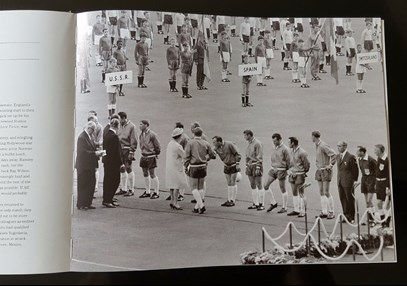
The stage was set; would the players live up to the high expectations of those watching from the stands? Looking back, it's easy to feel that success was never in doubt, but it wasn't exactly a "walk in the park" for Ramsey's boys.
Extracted from the book, which is available to pre-order now. Copies of the Collectors' Edition are limited to 500 copies and are signed by hat-trick hero Sir Geoff Hurst.
Competition Time!
For your chance to WIN a copy of the 1966 World Cup Final on DVD, signed by hat-trick hero and England legend Sir Geoff Hurst, then head on over to our social media channels to enter!
Simply LIKE and SHARE the post to enter!
Simply RT & FOLLOW US to enter!
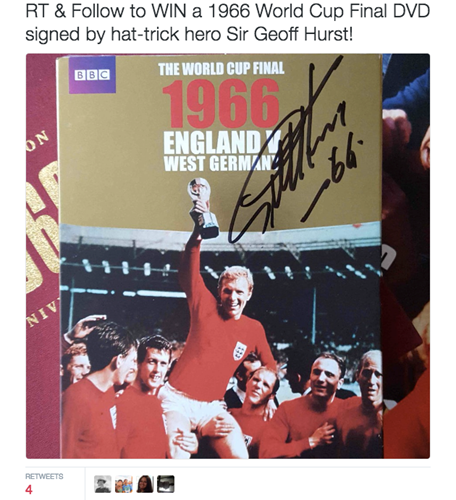
A Sneak Peek At The Book!
The books have arrived in our warehouse, meaning all pre-orders will soon be shipping! Pre-order your copy now.
Here's a sneak peek at the book to whet your appetite!
Pickles Saves the Day!
One important feature in the forthcoming book, 1966 - The 50th Anniversary, explains how a black-and-white mongrel dog became the most unlikely hero from the 1966 World Cup - before a ball was even kicked!
The Jules Rimet Trophy - solid gold, 10in. high and insured for £30,000 - was stolen whilst on show at an exhibition at the Methodist Central Hall in Westminster in March of 1966, four months before the tournament was due to kick-off. The police had very little to go on until, after a week of tirelessly searching, the FA Chairman, Joe Mears, posted a £15,000 reward for whoever found the trophy.
Scotland Yard mounted a strict operation, whereby Detective Inspector Leonard Buggy made the arrest of a 46-year-old man. Upon questioning, he claimed to be merely a ‘middleman’ and that he had no knowledge of the trophy's whereabouts, yet he was sentenced to two years imprisonment.
Panic had begun to set in, and the FA ordered a replica be produced to replace the missing trophy; when, out of nowhere, a black-and-white Mixed Breed Collie called Pickles, found the trophy whilst out for a walk with owner David Corbett in Beulah Hill, South London.
Pickles became a national treasure, appearing on several television programmes, including Blue Peter and Magpie. He starred in a film alongside Eric Sykes and June Whitfield in The Spy With the Cold Nose. He was crowned ‘Dog of the Year’, and awarded a years’ supply of pet food by manufacturer Spillers.
Sadly, a year later, Pickles was strangled by his own lead whilst chasing a cat. However, his role in England’s World Cup story has never been forgotten and his collar is on display at the National Football Museum.
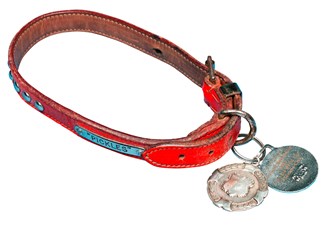
Pickles' collar, on display at the National Football Museum. Image supplied by the National Football Museum.
For more great stories from the 1966 World Cup be sure to pre-order your copy of the book!
Advertising at the Tournament
We live in an age where business and advertising has risen to play a hugely significant role in sport, particularly so in football. Mammoth sums are paid for players before they’ve even proven themselves; emerging markets - China for instance - are trying to buy into the game at an elite level; and fans are being frozen-out by ever-increasing ticket prices. But when did this process all begin? Did the 1966 World Cup have anything to do with it?
The tournament blazed a trail for commercialism with an explosion in merchandising in particular. A huge variety of products branded with the features of ‘World Cup Willie’, a lion in Union Jack waistcoat and the first official World Cup mascot, found their way into the market. Over the half-century since, this merchandise, including items such as assorted hats, T-shirts, beer glasses and tea towels, has become highly prized by collectors of both football memorabilia and ‘60s kitsch.
Technological developments in communications, meanwhile, helped make the finals in England the first genuinely global World Cup. Television was still a relatively new concept, but nonetheless images from the matches were beamed to 69 different stations of more than 400 million viewers across the planet. And while only 16 nations actually competed at the finals, press accreditation was provided for reporters, photographers and radio and TV folk from four times as many countries, including Iran, Iraq and Sudan. Yet, at the same time as this great coming together of the world’s media, the British government decided that the best way to publicise the tournament was by the somewhat dated means of the poster, hundreds of which were stuck on the walls at airports, train stations and social clubs. It’s a wonder town criers weren’t roped in to announce the latest World Cup news in market squares up and down the country!
What follows are some examples of adverts and memorabilia from the tournament, taken directly from the book and sourced from our partners David Duncan and the National Football Museum.
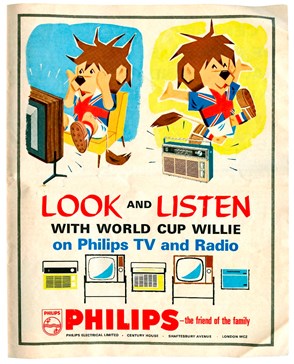
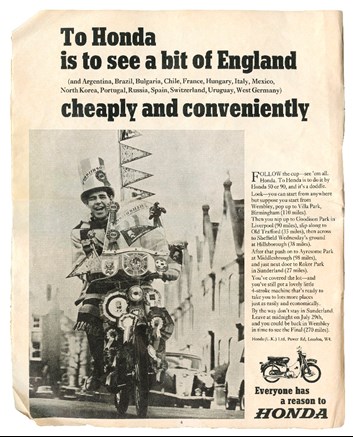
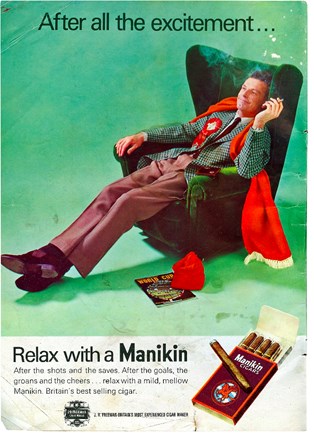
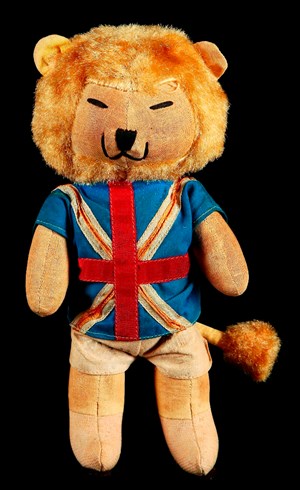

The Stadia
In all, there were eight stadiums used at the 1966 World Cup, spread out across London, the Midlands, the North West, and the North East. Fans turned out in their masses to support their teams, with very few attendances being far below capacity. The highest recorded attendance was England vs France in the Group Stages at Wembley, attracting 98,270 supporters, surprisingly beating the Final’s attendance of 96,924.
London: Wembley and White City Stadium
Group 1:
England
Uruguay
Mexico
France
Built in 1923 and referred to as the “home of football”, the original Wembley Stadium hosted the World Cup Final. The instantly recognisable white towers were its' trademark, giving the stadium a unique sense of identity. Equally famous were the 39 steps, which led from the pitch up to the Royal Box, where the trophy would be collected from. In 1966, England played all of their matches at Wembley - much to the dismay of the rest of the country. In fact, only three other matches, not involving England, were played here: France vs Mexico (1-1 draw); Mexico vs Uruguay (0-0 draw); Portugal vs Soviet Union (2-1, 3rd Place Playoff).
White City Stadium was originally built in 1908 for the Summer Olympics. Located in the Borough of Hammersmith and Fulham, the stadium was regarded as the blueprint for the modern-era seater stadium. More popular for its athletics and greyhound racing, only one match was hosted here, Uruguay vs France (2-1), and the stadium was demolished in 1985.
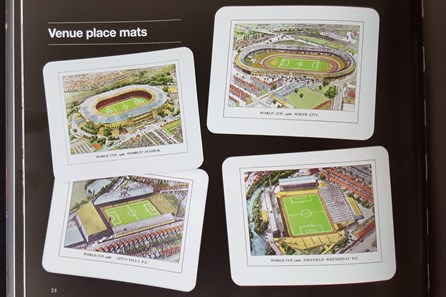
The Midlands: Villa Park and Hillsborough
Group 2:
West Germany
Argentina
Spain
Switzerland
One of the oldest sports grounds in the country, Villa Park was originally used as a recreational area in the grounds of a Jacobean stately home. In 1894, Aston Villa FC were growing tired of their Wellington Road ground and sounded out the venue as a potential new location to play their matches. Villa Park hosted three matches at the 1966 World Cup, including Argentina vs Spain (2-1), Argentina vs West Germany (0-0), and West Germany vs Spain (2-1).
Hillsborough has been the home of Sheffield Wednesday FC since 1899, after it was selected to replace the land their previous site stood on as it was required for railway expansion. The stadium hosted four matches in 1966, the most notable being West Germany’s 4-0 humiliation of Uruguay in the Quarter Finals. Hillsborough proved to be a fortunate ground for West Germany, who also recorded wins over Switzerland (5-0) and Spain (2-1) there. The other match it hosted was Spain vs Switzerland (2-1).
The North West: Old Trafford and Goodison Park
Group 3:
Portugal
Hungary
Brazil
Bulgaria
Dubbed the “Theatre of Dreams” by Bobby Charlton, Old Trafford is perhaps the second-most iconic football stadium after Wembley. Built in 1910, the ground has served England’s most decorated club, Manchester United, ever since. The club briefly moved to Maine Road from 1941-1949 due to bomb damage from the Second World War, but have enjoyed huge success at Old Trafford for over 100 years. In 1966, Old Trafford only hosted three matches: Eusébio’s Portugal vs Hungary (3-1); Portugal vs Bulgaria (3-0); and Hungary vs Bulgaria (3-1).
As one of the world’s oldest purpose-built football grounds, Goodison Park has been the home of Everton FC since 1892. Believe it or not, but the Toffees once played their home matches at Anfield - the home of arch-rivals Liverpool FC! Goodison hosted five matches at the 1966 World Cup, including all three of Brazil’s group matches featuring the much-adored Pelé. Brazil were disappointing at the tournament, bowing out in the Group Stages, beating Bulgaria (2-0), before heavy defeats against Hungary (3-1), and Portugal (3-1).
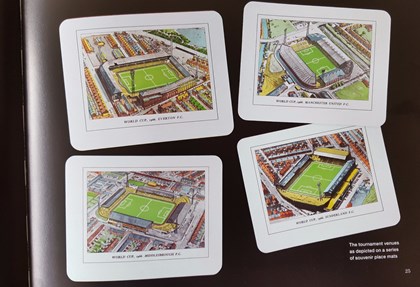
The North East: Ayresome Park and Roker Park
Group 4:
Soviet Union
North Korea
Italy
Chile
Ayresome Park is the former home of Middlesborough FC, dating from 1903. The stadium was built due to Middlesborough becoming recognised by the Football League, meaning the club needed an improved stadium to meet requirements. It was used in 1966 for three matches: Soviet Union vs North Korea (3-0); Chile vs North Korea (1-1); and, in what was probably the biggest shock result from the tournament, North Korea vs Italy (1-0). The Teesside fans really got behind minnows North Korea, with 3,000 of them travelling to Liverpool to watch their quarter final defeat against Portugal (5-3).
Home To Sunderland AFC for just shy of 100 years, Roker Park was about as typical a football ground as you could get; wooden terraces, clock tower, no seats and a crush barrier for safety. It was only the second ground to install floodlights, after Arsenal’s Highbury, doing so in 1952. Four matches were played there in 1966, including Italy vs Chile (2-0), Soviet Union vs Italy (1-0), Soviet Union vs Chile (2-1), and Soviet Union vs Hungary (2-1, Quarter Final).
A wealth of information about the stadiums and the matches played at them can be found in the book.
Warm-Up Matches
England rounded off their preparations for Euro 2016 by winning all of their pre-tournament friendly matches. This was a feat achieved by Sir Alf Ramsey’s eventual World Cup winning side of 1966, marking another fateful statistic linking the two sides.
50 years ago, England went on a four-match European tour, making up their World Cup warm-up campaign. In their first match against Finland in Helsinki, England played a 4-4-3 formation with one winger, Liverpool’s Ian Callaghan, and laboured to a 3-0 win. Roger Hunt, Martin Peters and Jack Charlton scored the goals, whilst Alan Ball missed a penalty.
Three days later England took on Norway in Oslo with a four-man-attack that included two wingers, Manchester United’s John Connelly and Terry Paine of Southampton. Norway took a shock lead, before England turned it around and replied by scoring six goals, to win the match 6-1. Bobby Moore scored the goal of the game with a curling shot from the edge of the penalty area, while Connelly was also on target. But it was Jimmy Greaves who stole the show, netting four goals and looking as fit as a fiddle after missing three months of the 1965/66 domestic season through illness.
The tour then moved on to Denmark, where England secured a 2-0 victory thanks to a Jack Charlton header and a goal from Arsenal midfielder George Eastham. However, it was certainly not a convincing display and there were concerns over the prolificacy of a Greaves and Hurst partnership in attack; so much so that coach Ramsey was considering dropping Hurst from his 22 man squad and replacing him with one of the two dozen other forwards he had tried out in his reign as England manager!
Yet, as we all know, Hurst kept his place in the squad, but did not feature in their final warm-up match: a tough challenge against a very physical Poland side. Ramsey selected a 4-1-3-2 formation (dispensing of the wingers entirely), in what would be the same formation that led England to World Cup glory. In front of a huge crowd of 80,000 in Chorzow, England dug out a 1-0 win, with Hunt scoring the winning goal via a stunning volley from a Bobby Charlton cross.
With four wins from four, twelve goals scored and only one conceded, the mini-tour turned out to be a great success. England were prepared and Ramsey had drummed a winning mentality into his players. But can the current crop of players put their impressive form and winning-run to good use in France this summer?
Extracted from 1966: The 50th Anniversary
A Nation Prepares
The current crop of England players set off for France today ahead of the 2016 edition of the European Championships. On board a private jet, Roy Hodgson and his squad of 22 players left English soil in the hope of returning with the Henri Delaunay trophy next month; thus ending 50 years of misery for English football. But what is perhaps most coincidental about the date is that today marks the very same day that Sir Alf Ramsey took his 1966 squad off to England’s pre-World Cup training base at Lilleshall. Good omen? Or, more likely, a sheer coincidence?
Whilst the tag of the modern-day footballer brings with it the flashy cars, outlandish pay-packets and God-awful haircuts, the one thing that links them with their humble forefathers is their hard work and dedication. Much like todays players, having to live under Hodgson’s “Fort Knox”-style security network and rigorous training regimes, Sir Alf’s players weren’t exactly taking it easy either. Ramsey had his squad of 27 players (a preliminary squad yet to be whittled down) put through lung-busting exercises and high-tempo practice matches. With his trusted assistants, Les Cocker and Harold Shepherdson, it wasn’t long until the players had a new name for their Shropshire base: “Stalag Lilleshall”.
The players were ordered to stay within the grounds of the hotel, leaving certain characters pining for the outside world. Eventually, three of them - Alan Ball, Nobby Stiles and John Connelly of Manchester United - defied Ramsey and set off for the local golf club for a drink. They were spotted and sent straight to Ramsey’s office, fearing that they would be sent home. However, the trio escaped with a stern telling off. “We are here for a purpose,” Ramsey warned them. “I just want to say that if anyone gets the idea of popping out for a pint, then they will be finished with the squad forever.”
Hodgson’s squad are based in the historic French town of Chantilly, famed for its horse racing culture. With rooms in the five-star Auberge de Jeu de Paume, the England players can relax after training in complete luxury, sampling espressos and delicate pastries at one of the town’s many coffee shops and patisseries. Ramsey’s triumphant squad were not so lucky, with Jack Charlton describing the training camp at Lilleshall as “an exercise in pushing the human mind and frame to the utmost level of endurance - and then some”; but, 50 years on, we know just how that paid off!

